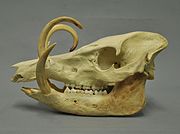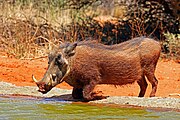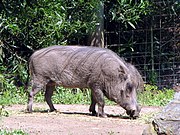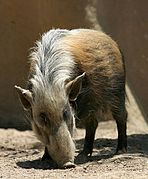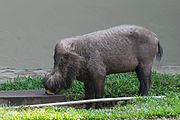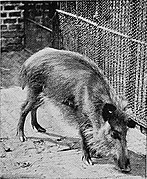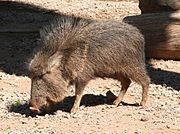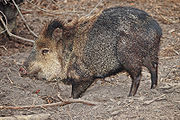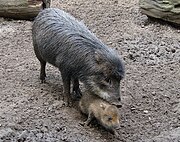Suina, also known as Suiformes, is a suborder of omnivorous, non-ruminant hoofed mammals in the order Artiodactyla. A member of this clade is called a suine. It includes the family Suidae, termed suids or colloquially pigs or swine, as well as the family Tayassuidae, termed tayassuids or peccaries. Suines are largely native to Africa, South America, and Southeast Asia, with the exception of the wild boar, which is additionally native to Europe and Asia and introduced to North America and Australasia, including widespread use in farming of the domestic pig subspecies. Suines range in size from the 55 cm (22 in) long pygmy hog to the 210 cm (83 in) long giant forest hog, and are primarily found in forest, shrubland, and grassland biomes, though some can be found in deserts, wetlands, or coastal regions. Most species do not have population estimates, though approximately two billion domestic pigs are used in farming, while several species are considered endangered or critically endangered with populations as low as 100.

The 20 extant species of Suina are split between the Suidae family, containing 17 extant species belonging to six genera, and the Tayassuidae family, containing three species in three genera. All extant suids are members of the Suinae subfamily; extinct species have also been placed into Suinae as well as other subfamilies. Dozens of extinct Suina species have been discovered, though due to ongoing research and discoveries the exact number and categorization is not fixed.[1][2]
Conventions
| Conservation status | |
|---|---|
| EX | Extinct (0 species) |
| EW | Extinct in the wild (0 species) |
| CR | Critically Endangered (1 species) |
| EN | Endangered (4 species) |
| VU | Vulnerable (6 species) |
| NT | Near threatened (2 species) |
| LC | Least concern (7 species) |
| Other categories | |
| DD | Data deficient (0 species) |
| NE | Not evaluated (0 species) |
Conservation status codes listed follow the International Union for Conservation of Nature (IUCN) Red List of Threatened Species. Range maps are provided wherever possible; if a range map is not available, a description of the species's range is provided. Ranges are based on the IUCN Red List for that species unless otherwise noted. All extinct species or subspecies listed alongside extant species went extinct after 1500 CE, and are indicated by a dagger symbol "†".
Classification
The suborder Suina consists of 20 extant species in nine genera, divided into dozens of extant subspecies. These are split between the Suidae family, containing 17 species belonging to 6 genera, and the Tayassuidae family, containing 3 species in 3 genera. This does not include hybrid species such as boar–pig hybrids or extinct prehistoric species.
- Family Suidae (Pigs)
- Genus Babyrousa: three species
- Genus Hylochoerus: one species
- Genus Phacochoerus: two species
- Genus Porcula: one species
- Genus Potamochoerus: two species
- Genus Sus: eight species
- Family Tayassuidae (Peccaries)
Suines
The following classification is based on the taxonomy described by Mammal Species of the World (2005), with augmentation by generally accepted proposals made since using molecular phylogenetic analysis. There are several additional proposals which are disputed, such as the creation of a fourth species of peccary, the giant peccary (Pecari maximus), which are not included here.[3]
Suidae
| Common name | Scientific name and subspecies | Range | Size and ecology | IUCN status and estimated population |
|---|---|---|---|---|
| Buru babirusa | B. babyrussa (Linnaeus, 1758) | Buru, Mangole, and Taliabu islands in Indonesia | Size: 85–110 cm (33–43 in) long, plus 20–32 cm (8–13 in) tail[4] Habitat: Forest and inland wetlands[5] Diet: Fruit and browse[5] | VU
|
| North Sulawesi babirusa | B. celebensis (Deninger, 1909) | Sulawesi and nearby Indonesian islands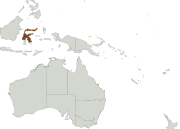 | Size: 85–110 cm (33–43 in) long, plus 20–32 cm (8–13 in) tail[6] Habitat: Forest and inland wetlands[7] Diet: Fruit and browse[7] | VU
|
| Togian babirusa | B. togeanensis (Sody, 1949) | Togian Islands of Indonesia | Size: Unknown, but likely the largest babirusa species[8][9] Habitat: Forest, inland wetlands, and intertidal marine[10] Diet: Fruit, rhizomes, tamarinds, cacao, herbs, and vegetables[8] | EN
|
| Common name | Scientific name and subspecies | Range | Size and ecology | IUCN status and estimated population |
|---|---|---|---|---|
| Giant forest hog | H. meinertzhageni Thomas, 1904 Three subspecies
| Scattered central Africa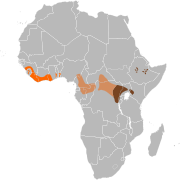 | Size: 130–210 cm (51–83 in) long, plus 25–45 cm (10–18 in) tail[11] Habitat: Forest[12] Diet: Large variety of plants, particularly herbaceous plants[12] | LC
|
| Common name | Scientific name and subspecies | Range | Size and ecology | IUCN status and estimated population |
|---|---|---|---|---|
| Common warthog | P. africanus (Gmelin, 1788) Four subspecies
| Sub-saharan Africa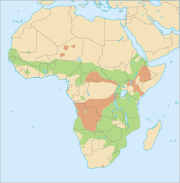 | Size: 90–150 cm (35–59 in) long[13] Habitat: Forest, savanna, shrubland, and grassland[14] Diet: Grass, as well as roots, berries, bark, and carrion[13][14] | LC |
| Desert warthog | P. aethiopicus (Pallas, 1766) Two subspecies
| Eastern Africa | Size: 100–145 cm (39–57 in) long[16] Habitat: Savanna and shrubland[17] Diet: A variety of grass, shrubs, and tubers, as well as fruit and insects[16][17] | LC
|
| Common name | Scientific name and subspecies | Range | Size and ecology | IUCN status and estimated population |
|---|---|---|---|---|
| Pygmy hog | P. salvania (Hodgson, 1847) | Southern Bhutan and northwest India | Size: 55–71 cm (22–28 in) long, plus tail[18] Habitat: Grassland[19] Diet: Roots, grass, tubers, and invertebrates[20][19] | EN
|
| Common name | Scientific name and subspecies | Range | Size and ecology | IUCN status and estimated population |
|---|---|---|---|---|
| Bushpig | P. larvatus (F. Cuvier, 1822) Six subspecies
| Southeastern Africa | Size: 100–150 cm (39–59 in) long[21] Habitat: Forest and shrubland[22] Diet: Roots, tubers, fruit, invertebrates, small vertebrates, and carrion[21][22] | LC
|
| Red river hog | P. porcus (Linnaeus, 1758) | Western Africa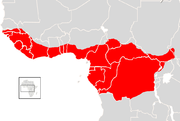 | Size: 100–150 cm (39–59 in) long, plus 30–40 cm (12–16 in) tail[23] Habitat: Forest[24] Diet: Fruit and seeds, as well as carrion[24] | LC
|
| Common name | Scientific name and subspecies | Range | Size and ecology | IUCN status and estimated population |
|---|---|---|---|---|
| Bornean bearded pig | S. barbatus Müller, 1838 Two subspecies
| Southeast Asia | Size: 100–170 cm (39–67 in) long, plus 20–50 cm (8–20 in) tail[25] Habitat: Forest, inland wetlands, neritic marine, and intertidal marine[26] Diet: Roots, fungi, invertebrates, small vertebrates, turtle eggs, carrion, and a variety of plants[26] | VU
|
| Celebes warty pig | S. celebensis Müller, Schlegel, 1843 Three subspecies
| Indonesian island of Sulawesi | Size: 80–130 cm (31–51 in) long[27] Habitat: Forest, grassland, and inland wetlands[28] Diet: Roots, fallen fruit, leaves, and young shoots, as well as invertebrates, small vertebrates, and carrion[28] | NT
|
| Javan warty pig | S. verrucosus F. Boie, 1832 Two subspecies
| Indonesian islands of Java and Bawean | Size: 90–190 cm (35–75 in) long[29] Habitat: Forest and grassland[30] Diet: Omnivorous; wide variety of plants and small vertebrates[29][30] | EN
|
| Oliver's warty pig | S. oliveri Groves, 1997 | Philippines island of Mindoro | Size: Specific measurements not available, but likely similar to the Philippine warty pig[31][32] Habitat: Forest, savanna, shrubland, and grassland[33] Diet: Believed to eat a wide variety of plant and animal matter[33] | VU
|
| Palawan bearded pig | S. ahoenobarbus Huet, 1888 | Philippines | Size: 100–160 cm (39–63 in) long[34] Habitat: Forest[35] Diet: Omnivorous; wide variety of plants, invertebrates, small vertebrates, and carrion[34][35] | NT
|
| Philippine warty pig | S. philippensis Nehring, 1886 Two subspecies
| Western Philippines | Size: Specific measurements not available[31][36] Habitat: Forest, shrubland, and grassland[37] Diet: Tubers, fruit, and invertebrates[36][37] | VU
|
| Visayan warty pig | S. cebifrons Heude, 1888 Two subspecies
| Visayan Islands in the Philippines | Size: 90–125 cm (35–49 in) long, plus 23 cm (9 in) tail[38] Habitat: Forest and grassland[39] Diet: Omnivorous; wide variety of plants and small vertebrates[38][39] | CR
|
| Wild boar | S. scrofa Linnaeus, 1758 Seventeen subspecies
| Eurasia and North Africa; introduced to parts of United States, South America, and Oceania | Size: 90–200 cm (35–79 in) long, plus 15–40 cm (6–16 in) tail[40] Habitat: Forest, savanna, shrubland, grassland, inland wetlands, and desert[41] Diet: Omnivorous; variety of plants, small vertebrates, invertebrates, and carrion[40][41] | LC
|
Tayassuidae
| Common name | Scientific name and subspecies | Range | Size and ecology | IUCN status and estimated population |
|---|---|---|---|---|
| Chacoan peccary | C. wagneri Rusconi, 1930 | Gran Chaco region of central South America | Size: 96–118 cm (38–46 in) long[43] Habitat: Savanna and shrubland[44] Diet: Cacti, as well as roots, fruit, and forbs[44] | EN
|
| Common name | Scientific name and subspecies | Range | Size and ecology | IUCN status and estimated population |
|---|---|---|---|---|
| Collared peccary | D. tajacu (Linnaeus, 1758) Fourteen subspecies
| South America, Central America, and southern North America | Size: 80–100 cm (31–39 in) long[45] Habitat: Forest, savanna, shrubland, grassland, and desert[46] Diet: Roots, tubers, fruits, seeds, as well as green plants, insects, and small animals[46] | LC
|
| Common name | Scientific name and subspecies | Range | Size and ecology | IUCN status and estimated population |
|---|---|---|---|---|
| White-lipped peccary | T. pecari (Link, 1795) Five subspecies
| South America and Central America | Size: 75–100 cm (30–39 in) long, plus 1–6 cm (0–2 in) tail[47] Habitat: Forest, savanna, shrubland, and grassland[48] Diet: Fruit, as well as a variety of plants, invertebrates, fungi and fish[48] | VU
|
References
Sources
- Burnie, David (2017). Animal: The Definitive Visual Guide. DK. ISBN 978-1-4654-7086-7.
- Melletti, Mario; Meijaard, Erik, eds. (2017). Ecology, Conservation and Management of Wild Pigs and Peccaries. Cambridge University Press. ISBN 978-1-316-95340-2.
- Wilson, Don E.; Mittermeier, Russell A., eds. (2011). Handbook of the Mammals of the World. Vol. 2 (Hoofed Mammals). Lynx Edicions. ISBN 978-84-96553-77-4.
- IUCN/SSC Hippo Specialist Group; IUCN/SSC Pigs and Peccaries Specialist Group (1993). Oliver, William L. R. (ed.). Pigs, Peccaries, and Hippos: Status Survey and Conservation Action Plan. International Union for Conservation of Nature. ISBN 978-2-8317-0141-7.
- Saha, Goutam Kumar; Mazumdar, Subhendu (2008). Threatened Mammals of India: Ecology and Management. Daya Publishing House. ISBN 978-81-7035-546-5.
